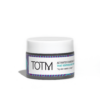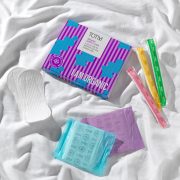Have you heard about Endocrine Disrupting Chemicals (EDCs)? Turns out, they are difficult to avoid yet can be harmful to your health. Here, Science Writer (and TOTM customer) Stephanie Organ explains all about EDCs:
“I try to look after myself. I eat organic when I can and, when not, I wash my fruit and veg thoroughly to remove any nasties. I’ve even changed my cosmetics and toiletries to more natural alternatives. But one thing has been bothering me – invisible chemicals which mimic our hormones, chemicals which we are exposed to daily without us even knowing it.
What are these chemicals?
Here’s where it gets technical. These are hormone mimicking chemicals, known as Endocrine Disrupting Chemicals (EDCs). They are in abundance across Europe. Our own hormones play a crucial role in our healthy function from simple needs, like hunger, to the more complex, like reproduction. EDCs mimic our hormones and have been linked to numerous health concerns, including obesity, diabetes, and even cancer.
In fact, a series of reports by the world’s EDC experts estimate the cost of exposure to European health care being upwards of €157bn per year.
I spoke to Juliette Legler, Professor of Toxicology and Environmental Health at Brunel University and a leading expert in the effects of chemical exposure, about this figure. “They’re high numbers and not even the worst-case scenario”, she exclaims. “The numbers of chemicals in our environment list about one hundred thousand to a million.”
EDCs in Feminine Hygiene Products
I wanted to draw attention to EDCs because feminine hygiene products contain EDCs. Femcare products can contain:
- Parabens – a group of preservatives in many personal care products including cosmetics.
- Phthalates – chemicals of particular concern. Phthalates are used in products including hair care products, nail polish and milk. Some, such as diethyl phthalate, can be found in fragrance.
- Bisphenol A (BPA) – found in plastics including water bottles, food packaging, and even the coating on till receipts. Many feminine hygiene products have plastic applicators.
- Dioxins – a by-product of the bleaching process in tampon production. The World Health Organisation deems these chemicals to be highly toxic. They have a cumulative effect over time.
Where else are they found?
With chemicals being widely used in consumer products, electronics and agriculture, human exposure is unavoidable. Many EDCs are food contaminants, but inhalation (EDCs can sit in dust which we end up by breathing in) and absorption through the skin are well-known pathways too.
Effect on female health
The effects aren’t the same for both sexes – women appear to be more susceptible than men. “The effects of EDCs on male and female offspring are completely different. Not only do we [females] have different exposures but we also react differently to these chemicals when we are exposed to them early in life” explains Juliette Legler.
This could be due to women’s bodies being naturally higher in fat (fat accumulates chemicals to protect the surrounding organs from toxins), hormonal differences, living longer and using an average of 12 personal products per day, compared to men who use 6. Additionally, a US study in 2009 looking at human exposure to environmental chemicals detected several, including EDCs in 90-100% of the population.
What does this have to do with feminine hygiene I hear you cry?
Well, we each use around 11,000 disposable menstrual products in our lifetime and spend 6.5 years of our lives on our periods. With some chemicals, such as dioxins, having a cumulative effect this means we are exposing our bodies to 6.5 years’ worth of chemicals. This is just via this route alone. Equally, the vagina has an extremely rich blood supply and is highly water permeable in a way our skin is not. This means the absorption rate via the vagina is much more rapid than via the skin.
Additionally, the chemicals we absorb in this way go straight into the blood stream instead of going through, for example, the digestive system, which would have the potential for being metabolised by the body.
But what does this mean for our health? Well, according to scientists, the chemicals found in feminine care products can disrupt oestrogen signalling, amongst other hormones. Oestrogen is needed for development and maintenance of tissues including breast, uterus, vaginal, bone, skin, liver and brain. It is also thought to have a role in female mental well-being. As a result, processes including puberty, ovarian follicular development, uterine functions and even skin ageing are affected by exposure to hormones mimicking oestrogen.
What can we do?
Do not despair. I asked Professor Legler what we can do about limiting exposure and she assured me that “There’s a lot of good news. In Europe, there have been improvements in the way chemicals are regulated, and substantial changes in policy and law that ensure chemicals should reach certain baseline testing before they’re allowed to enter the market… really bad chemicals are no longer used or produced”.
There are also scientists all over the world researching EDCs. Juliette is working hard to develop quick and easy ways for industry to test their chemicals for certain effects. “There are some really good, socially aware and caring industry partners including pharmaceutical companies who really don’t want to be producing chemicals that have these effects”.
What can YOU do to limit your exposure to EDCs?
“I don’t want individuals to be thinking how they can be controlling their exposure because it’s really hard to do. [EDCs] shouldn’t be in the environment, and that’s what I am working towards…not telling women what not to eat or what not to put on their skin”, Juliette laughs. Although it should fall to industry to reduce these nasties, with so many of them silently contaminating our lives there are a few simple things we can do which have been shown to reduce exposure:
- Switch to a BPA-free drinks bottle.
- Reduce the amount of canned foodstuffs used – even tin cans are lined with BPA; never heat food in plastic containers.
- Wash fruit and vegetables.
- Vacuum frequently. Chemicals are emitted from household products and then reside in dust which we breathe in – children are more susceptible to this type of exposure as they are lower to the ground, are smaller, explore with their mouths, and are growing and developing which requires many hormones.
- Ventilate your home regularly. This can reduce the concentration of EDCs in your home environment.
With our bodies being bombarded by natural and manmade stressors, it is important to choose products which can help minimise this chemical flood. Personally, I feel lucky that I stumbled upon TOTM when looking for a tampon brand which wouldn’t irritate my sensitive, temperamental lady parts. It just so happened that as soon as I read all about the chemicals in other female products and the lack of chemicals in TOTM products, I knew I wanted to make the switch right there and then.
Found this article informative? Let us know in the comments below or drop us a comment @totmorganic. Thanks to Stephanie Organ for writing this post.






